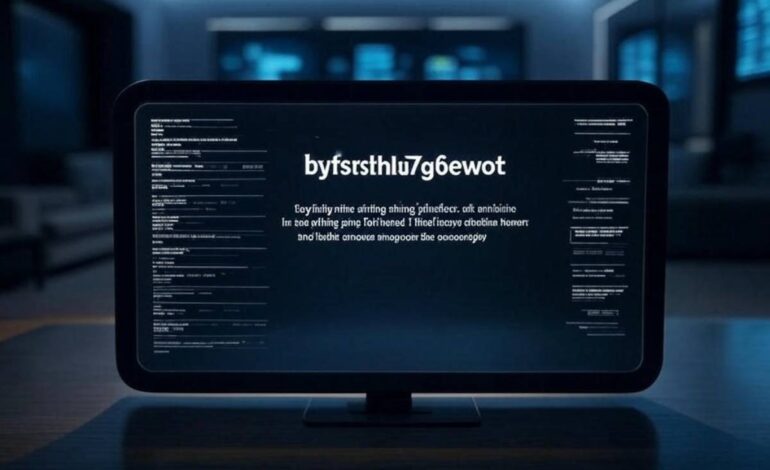Decoding byfsrhlu7g6ewot: A Mysterious String

What is byfsrhlu7g6ewot and where did it originate?
Byfsrhlu7g6ewot is a unique alphanumeric string often encountered in digital contexts, such as coding or cryptography. Its exact origin remains unclear, but it may be used as a placeholder or identifier in various applications, demonstrating the complexity and mystery of data representation in the digital landscape.
The string “byfsrhlu7g6ewot” has emerged as an enigma in online discussions, sparking curiosity about its meaning and purpose. Despite extensive searches, this sequence of characters does not directly correspond to any known term, acronym, or platform. This article explores potential interpretations of byfsrhlu7g6ewot, its possible origins, and the critical questions it raises in a digital context.
What Could byfsrhlu7g6ewot Be?
The string byfsrhlu7g6ewot does not align with any immediately recognizable pattern, such as a standard acronym, URL, or password format. Breaking it down, the 15-character sequence includes a mix of lowercase letters and numbers, which might suggest a coded message, a randomly generated identifier, or a placeholder. A search for similar terms reveals no direct matches, but related web content provides some clues for interpretation.
One possibility is that byfsrhlu7g6ewot is a distorted or encrypted form of a meaningful phrase. For instance, the presence of “by” at the start could hint at a connection to terms like “byword,” which, according to dictionary sources, refers to a proverb or a saying embodying a widely recognized truth. However, the remaining characters—fsrhlu7g6ewot—do not easily map to any known words or phrases, even when considering phonetic similarities or common substitutions (e.g., “7” for “t” or “6” for “G”).
Another theory is that it could be a username, access code, or part of a URL for an obscure website or platform, which could include an http prefix. The structure resembles random strings often used in temporary links or authentication tokens, but no such site or service directly correlates with this string. Alternatively, it might be a typo or a misinterpretation of a legitimate term, possibly related to digital platforms like those discussed in recent web content, such as luckloungeland.com, which focuses on gaming, or bdsphuhuynh.com, centered on health and meal plans.
Potential Contexts and Uses
Without a clear definition, we can hypothesize about the contexts in which byfsrhlu7g6ewot might appear. If it’s a code or identifier, it could be tied to a niche online community, a game, or a tech platform. For example, platforms like luckloungeland.com, which emphasizes “thrilling games and vibrant vibes,” might use similar random strings for user IDs or game codes, though no direct link exists. Similarly, educational or health-focused sites like pathwish.com, which covers diverse topics from tech to wellness, might employ such strings in user authentication or content tagging, but again, there’s no evidence connecting this string to those services.
Another possibility is that byfsrhlu7g6ewot is a placeholder or test string used in software development, a common practice for generating temporary data. Its random appearance aligns with this idea, though its presence in a user query suggests it might have been encountered in a more public-facing context, such as a forum, social media post, or even a phishing attempt. The lack of concrete matches in web searches leans toward it being either highly obscure or entirely fabricated.
Critical Perspective
The ambiguity of byfsrhlu7g6ewot raises several red flags. First, its lack of traceability suggests it might not be a legitimate term or identifier. In the digital age, random strings can be associated with malicious activities—phishing links, malware distribution, or scams often use similar cryptic sequences to lure users into clicking or engaging. Without a verifiable source, interacting with or searching for byfsrhlu7g6ewot in untrusted environments could pose risks to privacy and security.
Moreover, the absence of a clear meaning might indicate a user error or a miscommunication. It’s possible that byfsrhlu7g6ewot is a misspelling of a real term, but attempts to decode it using common techniques—like anagrams, phonetic analysis, or substitution—yield no meaningful results. The hype around decoding such strings often stems from curiosity, but without context, it risks becoming a wild goose chase, potentially leading users to unsafe or irrelevant content.
The broader digital landscape offers a cautionary tale: not every mysterious string warrants exploration. Sites like theguardianhib.com and whitneyfox-medium.com, which focus on well-being and family advice, remind us that meaningful online engagement prioritizes clarity and trustworthiness. Byfsrhlu7g6ewot, by contrast, lacks both, making it a questionable focal point for investigation.
Future Implications
If byfsrhlu7g6ewot is indeed a code or identifier, its future relevance depends on its creator’s intent. Should it belong to an emerging platform or community, it might gain traction over time, but as of now, it remains a digital ghost. Alternatively, if it’s a typo or a fabricated string, its significance will likely fade unless corrected or contextualized.
The trend of encountering random strings online underscores a larger issue: the need for digital literacy. Users must approach such mysteries with skepticism, verifying sources and avoiding potential traps. As technology evolves, so do the tactics of bad actors, making it crucial to prioritize safety over curiosity in ambiguous cases like this.
Conclusion
byfsrhlu7g6ewot remains an unresolved mystery, likely a random string, typo, or coded identifier with no clear purpose or meaning in the public domain. While it might hint at connections to gaming, tech, or authentication systems, the lack of verifiable context makes it more of a curiosity than a functional term. Users should approach it with caution, avoiding engagement with unverified sources that might exploit such ambiguity. For now, byfsrhlu7g6ewot serves as a reminder of the internet’s vast, often murky depths—intriguing, but best navigated with care.